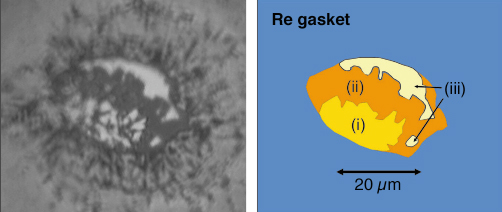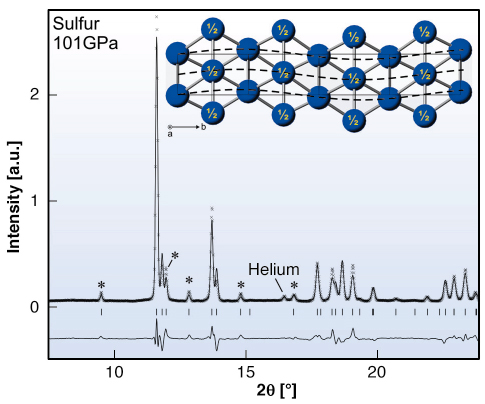- Home
- Users & Science
- Scientific Documentation
- ESRF Highlights
- ESRF Highlights 2005
- Materials Science
- Incommensurate Metallic Sulfur above 100 GPa
Incommensurate Metallic Sulfur above 100 GPa
The physical properties of a material at high pressure can be dramatically different to those observed at ambient conditions. For example, sulfur at ambient pressure is a yellow molecular insulating solid. Under compression, its resistivity decreases rapidly, until it becomes a metallic superconductor above 90 GPa. The superconducting temperature increases from Tc = 10 to 14 K over the pressure range 90–160 GPa [1], and at still higher pressures there is a further structural transition to another superconducting phase with a maximum Tc of 17.3(5) K at 200 GPa.
The crystal structure of the metallic phase of sulfur at 100 GPa has long been reported to be orthorhombic, and isostructural with the high-pressure phases of the other group VIa elements selenium (Se-IV) and tellurium (Te-III). However, using high-pressure diffraction techniques at both the ESRF and the SRS, we have recently shown that both Se-IV and Te-III are in fact monoclinic, with incommensurately modulated atomic coordinates [2]. Using X-ray powder diffraction techniques on beamline ID09, we have now investigated the structures and transitions in sulfur up to 101 GPa with the aim of determining whether the metallic phase is also incommensurately modulated. We used an X-ray wavelength of 0.418 Å focused down to a beamsize of 10 µm x 10 µm, and the 2-dimensional (2D) diffraction patterns were collected on a MAR345 image plate before being integrated azimuthally to give standard 1D diffraction profiles.
To obtain the highest quality diffraction data, we loaded powdered sulfur with helium as a pressure transmitting medium, which made it possible to determine the pressure of the illuminated part of the sample from the helium’s diffraction pattern and known equation of state.
 |
|
Fig. 31: Micrograph of the metallic sulfur sample at 101 GPa, as viewed through one of the diamond anvils of the pressure cell. The schematic diagram identifies (i) highly reflecting sulfur in contact with the diamond face, (ii) sulfur with helium between it and the diamond, and (iii) some of the transparent helium pressure medium illuminated from behind. |
The structural phase transition to the metallic phase was observed to start at 75 GPa, somewhat lower than previous studies, and single-phase profiles were observed above 95 GPa. A micrograph of the sample at 101GPa, which had the approximate dimensions 30 µm x 30 µm x 5 µm at this pressure, is shown in Figure 31, and illustrates the highly reflecting nature of the metallic phase. A diffraction pattern from the sample at the same pressure is shown in Figure 32, and is very similar to that observed previously from incommensurate Se-IV and Te-III. A Rietveld refinement to the same incommensurate structure is shown in Figure 32, and gives an excellent fit. All the diffraction peaks can be accounted for by the 4D superspace group I'2/m(0q0)s0, with the incommensurate wavevector q = 0.281(1) at 101 GPa and a single atom located at (0,0,0).
 |
|
Fig. 32: Rietveld refinement of incommensurate sulfur at 101 GPa. Tick marks show calculated positions of main and modulation peaks: asterisks identify some modulation reflections. The difference between the observed and calculated profiles is shown below the tick marks. Inset: four unit cells of the modulated structure viewed down the a axis. The modulation wave is indicated with dashed lines. |
Four unit cells of the structure of S-III at 101 GPa are shown as an inset to Figure 32. In the absence of the incommensurate modulation, all would be identical. However, the modulation, which has a wavelength of 1/q unit cells as shown with a dashed line in the inset to Figure 32, is incommensurate with the unit cell repeat, and thus the atomic coordinates in each unit cell are different.
On pressure decrease from the incommensurate phase, we found a previously unknown phase of sulfur below 90 GPa. The similarity of the diffraction patterns with those obtained previously from Se-III and Te-II shows that all three phases have the same triclinic structure [3].
In conclusion, we have shown that sulfur joins its group VIa neighbours selenium and tellurium in having a phase with an incommensurately modulated crystal structure at high pressure, and is the first element observed to have such a structure above 100 GPa. The results show that incommensurate structures are not limited to lower pressures, and suggest that further such structures will be found in other elemental systems at very high pressures.
References
[1] E. Gregoryanz, V.V. Struzhkin, R.J. Hemley, M.I. Eremets, H.K. Mao, and Y.A. Timofeev, Phys. Rev. B 65, 064504 (2002).
[2] C. Hejny and M.I. McMahon, Phys. Rev. Lett. 91, 215502 (2003).
[3] C. Hejny and M.I. McMahon, Physical Review B 70, 184109 (2004).
Principal Publication and Authors
C. Hejny (a), L.F. Lundegaard (a), S. Falconi (a), M.I. McMahon (a) and M. Hanfland (b), Physical Review B Rapid Communications 71, 020101(R) (2005).
(a) SUPA, School of Physics and Centre for Science at Extreme Conditions, The University of Edinburgh (UK)
(b) ESRF



